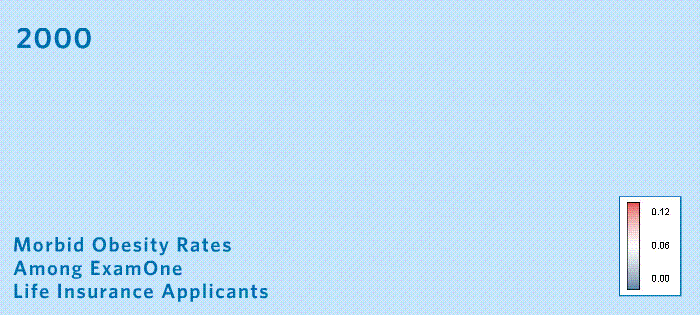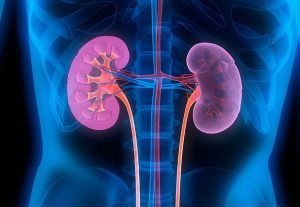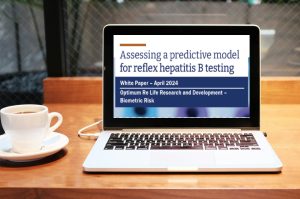Obesity is increasingly becoming one of several high-risk mortality indicators. Morbid obesity, which is in the top rank of obesity classification is defined as the Body Mass Index (BMI) greater than or equal to 40 kgm-2. (Standard World Health Organization’s BMI classification can be found here.) Since morbid obesity is closely linked to extremely high risks of diabetes, cancer and heart disease, it becomes very important to continue to monitor its geographic distribution and demographic patterns across the country. This report, which presents a preliminary statistical investigation on the geographic distribution of morbid obesity across the United States, provides insights and critical decision making information for health risk assessors and other relevant users.
Data Overview
Data sets for years 2000 – 2012 were analyzed. About 3.2 million records were available with height/weight measurements from which morbid obesity (BMI≥40) rates were calculated with a 3-digit zip code precision.

Preliminary Results
High Occurrence
Results reveal that locations around Arkansas, especially to the eastern parts, central Mississippi and west central Alabama are areas with high occurrence of morbid obesity in the country (see Fig. 1). Results further show that approximately 8-9% occurrence of morbid obesity are reported across each of these locations, indicating nearly 1 out of 10 life insurance applicants in these areas are morbidly obese.
Moderate Occurrence
Locations around New Mexico, north central Pennsylvania and West Virginia reported moderately morbid obesity occurrence. In addition, northeast Massachusetts, central Washington DC, central South Carolina and north eastern Oregon also recorded moderately morbid obesity. These locations are all within the 5% moderately morbid obesity range meaning nearly 1 out of 20 life insurance applicants in these areas are morbidly obese.
Low Occurrence
As might be expected, Colorado and northern California recorded a very low morbid obesity rate of approximately less than 1%. This suggests that nearly 1 out of 100 life insurance applicants in these areas are morbidly obese.
We have found that Colorado and northern parts of California reported the lowest rates of morbidly obese life insurance applicants, while the eastern parts of Arkansas reported the highest rates of morbidly obese life insurance applicants. Some of the suggested determining factors for the observed distribution patterns of morbid obesity across the country include level of exercise and good nutrition, education and income, weather conditions and possibly social pressure. Nearly 7 out of 10 residents of Colorado are bicyclists. With nearly 330 days of sunshine per year in Colorado, residents have more opportunities for outdoor fitness activities.
It is interesting to note that our findings are in agreement with the majority of previous obesity studies. However, these previous studies used somewhat inaccurate obesity data because their data was dependent on the applicants’ sincerity in reporting their obesity status. Data demonstrates that most people are not truthful when reporting their obesity status, especially women. To receive the most accurate data for this study, we used obesity data computed directly from ExamOne screen laboratory results for life insurance applicants. Thus eliminating issues with applicants incorrectly reporting their obesity status. This study provides value-added contributions to correctly represent and understand the morbid obesity distribution across the United States.




















Obesity is increasingly becoming one of several high-risk mortality indicators. Morbid obesity, which is in the top rank of obesity classification is defined as the Body Mass Index (BMI) greater than or equal to 40 kgm-2. (Standard World Health Organization’s BMI classification can be found here.) Since morbid obesity is closely linked to extremely high risks of diabetes, cancer and heart disease, it becomes very important to continue to monitor its geographic distribution and demographic patterns across the country. This report, which presents a preliminary statistical investigation on the geographic distribution of morbid obesity across the United States, provides insights and critical decision making information for health risk assessors and other relevant users.
Data Overview
Data sets for years 2000 – 2012 were analyzed. About 3.2 million records were available with height/weight measurements from which morbid obesity (BMI≥40) rates were calculated with a 3-digit zip code precision.
Preliminary Results
High Occurrence
Results reveal that locations around Arkansas, especially to the eastern parts, central Mississippi and west central Alabama are areas with high occurrence of morbid obesity in the country (see Fig. 1). Results further show that approximately 8-9% occurrence of morbid obesity are reported across each of these locations, indicating nearly 1 out of 10 life insurance applicants in these areas are morbidly obese.
Moderate Occurrence
Locations around New Mexico, north central Pennsylvania and West Virginia reported moderately morbid obesity occurrence. In addition, northeast Massachusetts, central Washington DC, central South Carolina and north eastern Oregon also recorded moderately morbid obesity. These locations are all within the 5% moderately morbid obesity range meaning nearly 1 out of 20 life insurance applicants in these areas are morbidly obese.
Low Occurrence
As might be expected, Colorado and northern California recorded a very low morbid obesity rate of approximately less than 1%. This suggests that nearly 1 out of 100 life insurance applicants in these areas are morbidly obese.
We have found that Colorado and northern parts of California reported the lowest rates of morbidly obese life insurance applicants, while the eastern parts of Arkansas reported the highest rates of morbidly obese life insurance applicants. Some of the suggested determining factors for the observed distribution patterns of morbid obesity across the country include level of exercise and good nutrition, education and income, weather conditions and possibly social pressure. Nearly 7 out of 10 residents of Colorado are bicyclists. With nearly 330 days of sunshine per year in Colorado, residents have more opportunities for outdoor fitness activities.
It is interesting to note that our findings are in agreement with the majority of previous obesity studies. However, these previous studies used somewhat inaccurate obesity data because their data was dependent on the applicants’ sincerity in reporting their obesity status. Data demonstrates that most people are not truthful when reporting their obesity status, especially women. To receive the most accurate data for this study, we used obesity data computed directly from ExamOne screen laboratory results for life insurance applicants. Thus eliminating issues with applicants incorrectly reporting their obesity status. This study provides value-added contributions to correctly represent and understand the morbid obesity distribution across the United States.